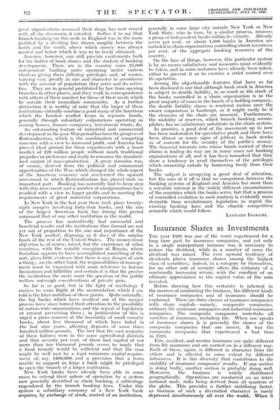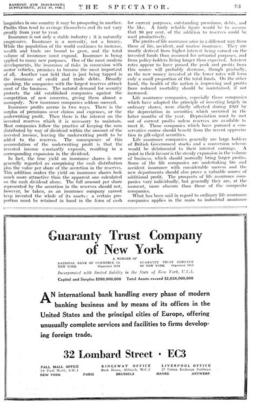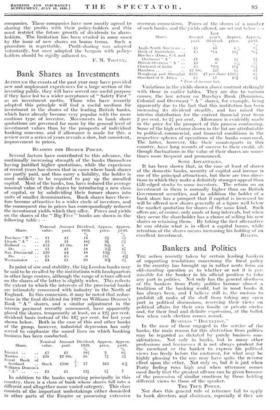Insurance Shales as Investments
Tim year 1929 was one of the worst experienced for a long time past by insurance companies, and yet only in a single unimportant instance was it necessary to reduce the dividend, while in a number of cases the dividend was raised. The ever upward tendency of dividends places insurance shares among the highest class of securities ; indeed, in a category by themselves, for no other sort of security offers the certainty of a continually increasing return, with the corollary of an ultimate appreciation in the capital value of the sum invested.
Before showing how this certainty is inherent in the manner of conducting the business, the different kinds of insurance companies and of insurance should be explained. There are three classes of insurance companies with share capitals—namely, composite companies, ordinary life assurance companies and industrial assurance companies. The composite companies undertake all varieties of insurance, including life. When one speaks of insurance shares it is generally the shares of the composite companies that are meant. It was the composite companies that experienced a bad time in 1929.
Fire, accident, and marine insurance are quite different from life assurance and are carried on in a different way. Each of these, again, is different its character from the others and is affected to some extent by different influences. It is this diversity that contributes to the stability of insurance companies'. results. If one section is doing badly, another section is probably doing well. Moreover, the business is z widely distributed geographically. Operations are conducted on an inter- national scale, risks being derived from all quarters of the globe. This provides a further stabilizing factor, as business of such a diversified character is rarely depressed.. simultaneously all: over the •world: :When it
languishes in one country it may be prospering in another. Profits thus tend to average themselves and do not vary greatly from year to year. Insurance is not only a stable industry ; it is naturally progressive. Insurance is a necessity, not a luxury. While the population of the world continues to increase, wealth and trade are bound to grow, and the total volume of insurance must expand. Insurance is being applied to many new purposes. One of the most modern developments, the insurance of risks in connexion with motor vehicles, promises to become the most important of all. Another vast field that is just being tapped is the insurance of credit and trade debts. Broadly speaking, the companies with the largest reserves attract most of the business. The natural demand for security protects the old established companies against the competition of new concerns, giving them almost a monopoly. New insurance companies seldom succeed.
Insurance profits accrue in two ways. There is the surplus of premiums over claims and expenses, or the underwriting profit. Then there is the interest on the invested reserves which it is necessary to maintain. Most companies follow the practice of keeping the suns distributed by way of dividend within the amount of the invested income, leaving the underwriting profit to be added to the reserves. The consequence of this accumulation of the underwriting profit is that the invested income constantly expands, resulting in a corresponding expansion in the dividend.
In fact, the true yield on insurance shares is now generally regarded as comprising the cash distribution plus the value per share of the accretion in the reserves. This addition makes the yield on insurance shares look much more attractive than the apparent one calculated on the cash dividend alone. The full amount per share represented by the accretion its the reserves should not, however, be taken, as an insurance company cannot keep invested the whole of its assets ; a certain pro- portion must be retained in hand in the form of cash
for current purposes, outstanding premiums, debts, and the like. A fairly reliable figure would be to assume that 90 per cent. of the addition to reserves could be used productively.
The profits of life assurance arise in a different way from those of fire, accident., and marine insurance. They are mostly derived from higher interest being earned on the invested funds than assumed for actuarial purposes, and from policy-holders living longer than expected. Interest rates appear to have passed the peak and Kolas from this source will probably decrease, though gradually, as the new money invested at the lower rates will form only a small proportion of the total funds. On the other hand, the health of the nation is improving and profits from reduced mortality should be maintained, if not increased.
Life assurance companies, especially those companies which have adopted the principle of invi-,1 log largely in ordinary shares, were chiefly affected during 1929 by the depreciation in securities which occurred in the latter months of the year. Depreciation must be suet out of current profits unless reserves are available to meet it. Those companies which have pursued a con- servative course should benefit from the recent apprecia- tion in gilt-edged securities.
Life assurance companies generally are large holders of -British Government stocks and a conversion scheme would be detrimental to their interest earnings. A point in their favour is the steady expansion in the volume of business, which should normally bring larger profits. Some of the life companies are undertaking lire and accident insurance with considerable success and the new departments should also prove a valuable source of additional profit. The prospects of life -assurance com- panies vary individually, but generally they arc, at the moment, more obscure than those of the composite companies. What has been said in regard to ordinary life assurance companies applies in the main to industrial assurance
companies. These companies. have now mostly agreed to sharing the profits with their policy-holders and this must restrict the future growth of dividends to share- holders. The limitation has been evaded in some cases by the issue of new shares on bonus terms. Such a procedure is regrettable. Profit-sharing was adopted voluntarily, but once adopted the bargain with policy- holders should be rigidly adhered to.
F. M. Too vnv.


















































 Previous page
Previous page